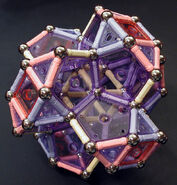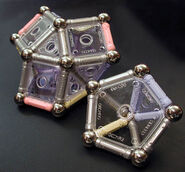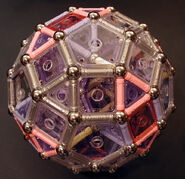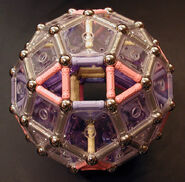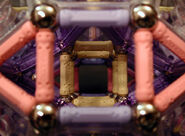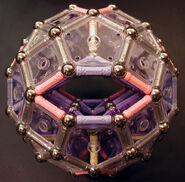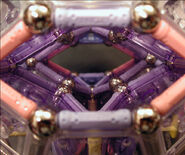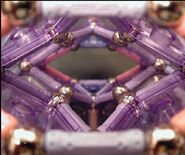m (Added links to Peter Jepsen's models (ref'd by Karl Horton)) |
m (Fixed minor errors in user links) |
||
| Line 66: | Line 66: | ||
<gallery> |
<gallery> |
||
| − | Image:6J91(P4) View 6 .jpg|0. |
+ | Image:6J91(P4) View 6 .jpg|0. Stewart's 6J<SUB>91</SUB>(P<SUB>4</SUB>) |
Image:E5-6J91(P4) View 1 with Bits .jpg|1. |
Image:E5-6J91(P4) View 1 with Bits .jpg|1. |
||
Image:E5-6J91(P4) View 2 with Filled Bits .jpg|2. |
Image:E5-6J91(P4) View 2 with Filled Bits .jpg|2. |
||
| Line 90: | Line 90: | ||
== Other models == |
== Other models == |
||
| − | [[User:Peter Jepsen]] built versions of this object (he credits Michele Grisoni, who works for the Geomag company). In these models the problematic outer pentagons are skipped. |
+ | [[User:Peter Jepsen|Peter Jepsen]] built versions of this object (he credits Michele Grisoni, who works for the Geomag company). In these models the problematic outer pentagons are skipped. |
[http://www.flickr.com/photos/geomag_model_team/1400771889/ View One] |
[http://www.flickr.com/photos/geomag_model_team/1400771889/ View One] |
||
[http://www.flickr.com/photos/peter_jepsen/458524550/ View Two] |
[http://www.flickr.com/photos/peter_jepsen/458524550/ View Two] |
||
| − | Thanks to [[User:Karl Horton]] for pointing out these links. |
+ | Thanks to [[User:Karl Horton|Karl Horton]] for pointing out these links. |
== Related links == |
== Related links == |
||
Revision as of 13:11, 15 January 2008
| FEED ME SEYMOUR!!! | |
 The Lunar-holed Rhombicosidodecahedron, Stewart's E5/6J91(P4) | |
| Type | Stewart Toroid |
| Panels | 20 × 24 × 36 × |
| Rods | 108 × |
| Spheres | 56 × |
| Author | PolyClare 19:06, 14 January 2008 (UTC) |
The Lunar-holed Rhombicosidodecahedron, Stewart's E5/6J91(P4).
This is a Rhombicosidodecahedron (called E5 by Johnson), with a 6-way hole through it made from Stewart's 6J91(P4), as described on pages 128-129 of Stewart's book (2nd ed.).
Stewart writes
It is unusual becuse each of the six openings is a lunar complex, rather than a single face, giving to the tunnels a novel, slit-like appearance.
By "lunar complex", Stewart is referring to a "lune", which Johnson defines to be: ![]()
WARNING: The pentagons only barely almost-fit in the outer shell of this model. That's because you can't comfortably fit a Geomag pentagon panel into the base of a pentagonal pyramid -- the angles are too extreme. For the pictures I took, I only put in the 4 visible pentagons, and then didn't breathe too heavily as I took the pictures, lest they pop out. If you look carefully at the pictures, you may be able to see that the pentagons stick out more than they should.
Counts of Rods, Spheres, Panels
From the page on Stewart's 6J91(P4), The totals were:
| 24 × |
6 × |
24 × |
120 × |
56 × |
The inner portion of a lune (inside the 6 outer rods and 6 spheres) is:
| 2 × |
1 × |
2 × |
Subtracting 6 inner lune portions from the totals above gives the "6J91(P4) Hole Subtotal":
| 12 × |
0 × |
24 × |
108 × |
56 × |
Now let's add the "alpha" parts (see Image #3 below) . We need to add just "top part" of the alpha: the clear panels and silver rods and central three spheres for each alpha. Each alpha resides above three pentagons of the 6J91(P4), and shares those pentagons with no other alpha. An alpha top part contains:
| 1 × |
3 × |
9 × |
3 × |
How many alpha top parts need to be added? Each alpha separately covers 3 pentagons, and the 6J91(P4) has 24 pentagons. Therefore 24/3 = 8 alpha top parts must be required.
Additionally, 12 pentagons (representing the pentagonal pyramid in Image #3 below) must be added.
Therefore, the overall total must be the "6J91(P4) Hole Subtotal" plus 8 alpha top parts and plus 12 pentagons:
| 20 × |
24 × |
36 × |
180 × |
80 × |
Other views
Notes to come soon -- in the meantime, here are the pictures:
Other models
Peter Jepsen built versions of this object (he credits Michele Grisoni, who works for the Geomag company). In these models the problematic outer pentagons are skipped.
Thanks to Karl Horton for pointing out these links.
Related links
- Norman W. Johnson, "Convex Solids with Regular Faces", Canadian Journal of Mathematics, 18, 1966, pages 169–200.
